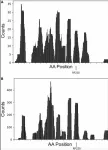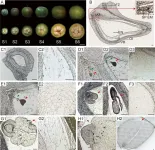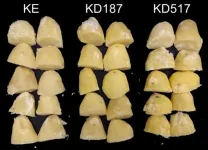(Press-News.org) People eat either because they are hungry or for pleasure, even in the absence of hunger. While hunger-driven eating is fundamental for survival, pleasure-driven feeding may accelerate the onset of obesity and associated metabolic disorders. A study published in Nature Metabolism reveals neural circuits in the mouse brain that promote hunger-driven feeding and suppress pleasure-driven eating. The findings open new possibilities for developing strategies to combat obesity.
“Ideal feeding habits would balance eating for necessity and for pleasure, minimizing the latter,” said co-corresponding author Dr. Yong Xu, professor of pediatrics – nutrition and associate director for basic sciences at the USDA/ARS Children’s Nutrition Research Center at Baylor College of Medicine. “In this study we identified a group of neurons that regulates balanced feeding in the brain.”
Previous studies have highlighted the role of neurons identified by the GABAergic proenkephalin (Penk) marker, an endogenous opioid hormone, on feeding and body weight balance. However, their contribution to regulating hunger- and pleasure-driven feeding had not been elucidated.
In this study, Xu and his colleagues showed that activation of Penk neurons in the brain region called diagonal band of Broca (DBB) of male mice supports an ideal feeding pattern, increasing hunger-driven feeding while reducing pleasure-driven eating.
“I was surprised by this finding,” Xu said. “We and other groups had previously shown that certain groups of neurons affect both feeding types in the same way – they either increase or decrease both types. Here we found that activating DBB-Penk neurons has opposite effects in the two types of feeding, they increase hunger-driven feeding while decreasing eating for pleasure.”
The researchers investigated the mechanism mediating these opposite effects. They discovered that DBB-Penk neurons project into two different brain areas, one regulates hunger-driven feeding and the other controls pleasure-driven eating.
“A subset of DBB-Penk neurons that projects to the paraventricular nucleus of the hypothalamus is preferentially activated upon food presentation during fasting periods, facilitating hunger-driven feeding,” Xu said. “On the other hand, a separate subset of DBB-Penk neurons that projects to a different brain region, the lateral hypothalamus, is preferentially activated when detecting high-fat, high-sugar (HFHS) foods and inhibits their consumption. This is the first study to show a neural circuit that is activated by a reward, HFHS, but leads to terminating instead of continuing the pleasurable activity.”
Strikingly, mice in which the entire DBB-Penk population had been eliminated, when given free choice of chow and HFHS diets, reduced consumption of chow but increased intake of the HFHS diet, resulting in accelerated development of obesity and metabolic disturbances.
“Our findings indicate that the development of obesity is associated with impaired function of some of these brain circuits in mice,” Xu said. “We are interested in further investigating molecular markers within the circuits that could be suitable targets for treatment of human diseases such as obesity.”
Other contributors to this work include Hailan Liu, Yongxiang Li, Meng Yu, Olivia Z. Ginnard, Kristine M. Conde, Mengjie Wang, Xing Fang, Hesong Liu, Longlong Tu, Na Yin, Jonathan C. Bean, Junying Han, Yongjie Yang, Qingchun Tong, Benjamin R. Arenkiel, Chunmei Wang and co-corresponding author Yang He, at Jan and Dan Duncan Neurological Research Institute at Texas Children's Hospital. The authors are affiliated with one of the following institutions: Baylor College of Medicine, Baylor’s USDA/ARS Children’s Nutrition Research Center, Jan and Dan Duncan Neurological Research Institute at Texas Children's Hospital and University of Texas Health Science Center at Houston.
This study was supported by grants from the USDA/CRIS (51000-064-01S, 3092-51000-062-04(B)S), Texas Children’s Research Scholar funds, American Heart Association (23POST1030352) and NIH NIDDK (1F32DK134121-01A1).
###
END
Eating for necessity or pleasure? There is a brain circuit for that
2024-08-08
ELSE PRESS RELEASES FROM THIS DATE:
TCR CDR3s and renalase-1 linked to increased melanoma survival
2024-08-08
“These findings indicate that renalase-1 is a potential antigen for TCR recognition in melanoma and could be considered as a target for immunotherapy.”
BUFFALO, NY- August 8, 2024 – A new research paper was published in Oncotarget's Volume 15 on August 5, 2024, entitled, “Chemical complementarity of tumor resident, T-cell receptor CDR3s and renalase-1 correlates with increased melanoma survival.”
As mentioned in the Abstract of this study, overexpression of the secretory protein renalase-1 negatively impacts the survival of melanoma and pancreatic cancer patients, while inhibition of renalase-1 signaling drives tumor ...
Department of Energy announces $4.6 million to fund public-private partnerships for fusion research
2024-08-08
Key Takeaways
-Fusion has the potential to provide abundant clean energy
-One to two-year awards range from $100,000 to $500,000
In a continuing effort to forge and fund public-private partnerships to accelerate fusion research, the U.S. Department of Energy (DOE) today awarded $4.6 million in 17 awards to U.S. businesses via the Innovation Network for Fusion Energy (INFUSE) program.
The goal of INFUSE is to accelerate fusion energy development in the private sector by reducing impediments to collaboration between business ...
Want to feel less stressed? Try the Mediterranean diet
2024-08-08
Following the Mediterranean diet versus the traditional Western diet might make you feel like you’re under less stress, according to new research conducted by a team from Binghamton University, State University of New York.
The findings suggest that people can lower their perception of how much stress they can tolerate by following a Mediterranean diet, said Lina Begdache, associate professor of health and wellness studies.
“Stress is recognized to be a precursor to mental distress, and research, including our own, has demonstrated that the Mediterranean diet lowers ...
Flow of sweetness: key sugar transporters identified for enhanced Camellia seed growth
2024-08-08
A recent study investigates the intricate mechanisms of sugar import in developing seeds of Camellia oleifera. By identifying key sugar transporters and analyzing their roles, the research provides significant insights into the molecular regulation of seed development. The findings highlight how these transporters, working alongside sucrose-metabolizing enzymes, facilitate efficient sugar import and partitioning. This study not only advances our understanding of seed development in Camellia oleifera but also suggests potential strategies to enhance seed yield and quality in this important ...
Not just an urban problem: new study reports higher rate of shootings by police across suburbs and rural areas
2024-08-08
Ann Arbor, August 8, 2024 – Media coverage of shootings by police typically involve urban incidents, giving the impression that the issue is unique to cities. However, national data built from the Gun Violence Archive tells a different story, showing a higher rate of shootings by police in rural and suburban areas than in cities during 2015-2020. A new study in the American Journal of Preventive Medicine, published by Elsevier, reports on the first nationwide, descriptive analysis of where, how often, and under ...
Drug shows promise for treating brain tumors resulting from breast cancer, UT Health San Antonio trial reports
2024-08-08
SAN ANTONIO, Aug. 8, 2024 – A drug effective in treating breast cancer shows new promise in addressing breast cancer with brain metastases or recurrent glioblastoma, as reported by results of a prospective window-of-opportunity trial at the University of Texas Health Science Center at San Antonio (UT Health San Antonio).
The window trial, in which patients agreed to receive a novel treatment before undergoing surgery, found that the drug Sacituzumab Govitecan was well-tolerated and showed signs of effectiveness for those whose breast cancer had progressed to brain tumors.
About half of all women with ...
Leading causes of death in the US, 2019-2023
2024-08-08
About The Article: This Viewpoint from the National Center for Health Statistics reports the leading causes of death in the U.S. from 2019 to 2023, including the emergence of COVID-19 and shifts in other top causes as pandemic deaths decreased.
Corresponding Author: To contact the corresponding author, Farida Bhuiya Ahmad, MPH, email hhi0@cdc.gov.
To access the embargoed study: Visit our For The Media website at this link https://media.jamanetwork.com/
(doi:10.1001/jama.2024.15563)
Editor’s Note: Please see the ...
Editing for resilience: CRISPR/Cas9 boosts potato stress resistance
2024-08-08
Scientists have made a significant breakthrough in agricultural biotechnology by using CRISPR/Cas9 to edit the potato genome, resulting in plants with increased resistance to both biotic and abiotic stresses. This innovation could lead to a new era of sustainable farming, where crops are naturally fortified against diseases and harsh environmental conditions, ensuring a stable food supply in the face of climate change and other global challenges.
The global food system is under increasing pressure due to the compounding effects of climate change, which exacerbates the prevalence of pests and diseases in crops. Potatoes, being the third most important food crop worldwide, are ...
Biocides are a useful tool to combat antibiotic resistance but appropriate use is vital, scientists suggest
2024-08-08
A recent review in the journal Sustainable Microbiology discusses how the use of biocides can promote well-being - but must only be used when there are clear benefits.
Biocide use should be restricted to applications where there are tangible benefits but also not unnecessarily restricted where genuine benefits can be demonstrated, the new review suggests.
The article ‘Sustainable application of biocides to promote hygiene and minimise antimicrobial resistance’ by scientists at the University of Manchester, UK, is published in Sustainable Microbiology, an Applied Microbiology International publication.
Contribution to sustainability
“We aimed to present ...
Wide genetic diversity in South American indigenous groups highlights diversity gap in genomics research
2024-08-08
Amazonians are as genetically different from Andeans as Europeans are from East Asians when it comes to genetic variants that affect the response to certain drugs, according to a commentary published August 8 in the journal Cell. These genetic variations can affect what side effects an individual experiences and influence drug dosage recommendations. Taking the genetic diversity within indigenous groups as an example, the scientists highlight the need to address the diversity gap in genomics research.
Historically, Native American populations have been viewed as ...



